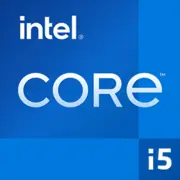Intel Core i5-13500HX

インテル Core i5-13500HX: ゲームと作業のためのラプター・レイクの力
2025年3月
2023年に発表されたインテル Core i5-13500HXプロセッサは、今でも中高価格帯のノートパソコンで需要があります。このチップは、ラプター・レイクのハイブリッドアーキテクチャ、14コア、高いエネルギー効率を兼ね備え、多様なタスクに適したユニバーサルなソリューションです。このCPUがどのようなユーザーに適しているのか、ゲームや作業アプリケーションでのパフォーマンス、そしてデバイス選びで注目すべき点について説明します。
アーキテクチャとプロセス技術: ハイブリッドコアと新たな最適化レベル
異種設計: P-CoreとE-Core
Core i5-13500HXはラプター・レイクのハイブリッドアーキテクチャを基にしており、コアは2種類に分けられます:
- 6つのパフォーマンスコア (P-Core)は、ハイパースレッディングをサポートし(12スレッド)、ターボブーストモードでの最大クロック周波数は4.8GHzです。これらのコアは「重い」タスク、つまりレンダリング、ゲーム、3Dモデリングを担当します。
- 8つのエフィシェントコア (E-Core)は、ハイパースレッディングなし(8スレッド)で、最大3.5GHzで動作し、バックグラウンドプロセスに最適化されています: システムのアップデート、音楽のストリーミング、アンチウイルスの動作など。
L3キャッシュの総容量は24MBで、マルチスレッドシナリオにおけるデータ処理が高速化されます。
インテル 7プロセス技術: 効率とパフォーマンス
チップはインテル7(以前はEnhanced SuperFinとして知られていた)10nmプロセスで製造されています。アルダーレイク(第12世代)と比較して、ラプター・レイクはトランジスタの最適化と電圧の低下により、エネルギー効率を15〜20%向上させました。
統合グラフィックス: 基本的なタスク向け
内蔵GPUは第13世代インテル UHDグラフィックス(32 EU、最大1.5GHz)で、以下をサポートしています:
- 8K HDRビデオ;
- HDMI 2.1;
- Quick Sync技術(ビデオエンコーディングの加速)とAdaptive Sync。
ゲームやグラフィック編集ソフトウェアでの作業には、ディスクリートGPU(例: NVIDIA RTX 4050以上)が必要です。
エネルギー消費とTDP: 力とバッテリー寿命のバランス
プロセッサの公称TDPは55Wですが、ターボモードでは最大157Wに達することがあります。これには効率的な冷却システムが必要です。このCPUを搭載したノートパソコンの大半は、2つのファンと4〜5本のヒートパイプを装備しています。
省エネルギー技術:
- インテル ダイナミックチューニング 3.0 — 負荷に応じて周波数を自動的に調整。
- スピードシフト EPP — タスク間の切り替え時の遅延を短縮。
- C-States — アイドル状態で未使用のコアを無効化。
バッテリー寿命を重視するユーザーには、OSの設定で「省エネルギー」モードを選択することをお勧めします。これによりP-Coreの周波数が2.5GHzに制限されますが、バッテリーの持ち時間が延びます。
パフォーマンス: ゲーム、レンダリング、オフィス作業でのテスト
オフィス作業とマルチメディア
- Google Chrome(20タブ)+ Zoom + Excel: CPUの負荷は30%を超えません。バックグラウンドプロセスはE-Coreに分配されています。
- DaVinci Resolveでの4Kビデオ編集: 10分のプロジェクトのレンダリングは8〜9分(i5-12500Hの12〜13分と比較)。
ゲーム
RTX 4060(ノートパソコン版)および16GB DDR5と組み合わせた場合:
- サイバーパンク2077 (ウルトラ, DLSSバランス): 65〜70 FPS。
- エーペックス レジェンズ (1440p): 120〜140 FPS。
- スロットリング: 長時間のセッション(1〜2時間)ではP-Coreの周波数が4.2GHzに低下し、過熱による影響がありますが、FPSの低下はわずか(5〜7%)です。
ターボモード: 最大限のパフォーマンスが必要な時
電源接続時にはターボブーストが自動で有効になります。例えば、Premiere Proでのビデオエクスポートは「バランス」モードに比べて25%速くなります。ただし、これは冷却ファンの騒音を48dBに増加させるため、オフィスではこのモードをオフにすることをお勧めします。
使用シナリオ: 誰にi5-13500HXは向いているか?
1. ゲーマー: RTX 4060/4070クラスのGPUと組み合わせ。
2. デザイナーとエンジニア: AutoCAD、Blender、Adobeスイートでの作業に最適。
3. 学生とオフィススタッフ: スムーズなマルチタスクを実現。
2025年のノートパソコンの例:
- MSI Katana 15 B13V: $1299 (RTX 4060, 16GB DDR5, 1TB SSD)。
- Lenovo Legion Pro 5i: $1399 (RTX 4070, 32GB DDR5, 240Hz display)。
バッテリー寿命: どのくらい持つのか?
バッテリー容量が80Whの場合:
- 動画視聴 (1080p): 最大7時間。
- Chrome + Office利用時: 5〜6時間。
- ネットワーク接続なしでのゲーム: 1〜1.5時間。
アドバイス: Advanced Optimus (NVIDIA)やSwitchable Graphics (AMD)を搭載したノートパソコンを選び、バッテリー駆動時には自動的に統合グラフィックスが有効になるようにしましょう。
競合との比較: AMD、Apple、そして過去の世代
- AMD Ryzen 7 7840HS (Zen 4): マルチスレッドタスクにおいては優れていますが(例: レンダリングは10%速い)、シングルスレッドには劣ります(Geekbench 6シングルコア: 2100)。
- Apple M3 Pro: エネルギー効率が高く(最大12時間のバッテリー寿命)、ゲームやWindowsソフトには向いていません。
- インテル Core i7-13700HX: 性能はわずか15%向上していますが、価格は$200〜$300高くなります。
長所と短所
強み:
- 高いマルチスレッドパフォーマンス。
- DDR5-5600およびPCIe 5.0のサポート。
- Windows 11向けの最適化。
弱み:
- 負荷時の冷却システムの騒音。
- 現代のゲームには不足する統合グラフィックス。
- Ryzen 7 7840Uよりバッテリー寿命が短い。
ノートパソコン選びのアドバイス
1. デバイスタイプ: ゲーミングモデル (ASUS ROG, MSI) またはモバイルワークステーション (Dell Precision)。
2. 冷却: 最低2つのファン + 銅製のヒートパイプ。
3. ディスプレイ: ゲーム用には144Hz以上; デザイン用には100% sRGB。
4. アップグレード性: RAMとM.2 NVMeのスロットが2つあるモデルを選ぶ。
最終結論
Core i5-13500HXは、手頃な価格で強力なノートパソコンを必要とする人にとって理想的な選択です($1200〜$1500)。ゲーム、ビデオ編集、エンジニアリングプログラムなどに対応できる一方で、重量(2.2kg以上)とバッテリー寿命の妥協が必要です。価格とパフォーマンスのバランスを求めているなら、このプロセッサは注目に値します。
基本
CPUの仕様
メモリ仕様
GPUの仕様
その他
ベンチマーク
他のCPUとの比較
ソーシャルメディアで共有する
または当サイトへのリンクを追加
<a href="https://cputronic.com/ja/cpu/intel-core-i5-13500hx" target="_blank">Intel Core i5-13500HX</a>